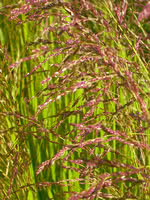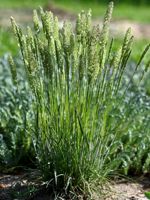Mon-Fri 9am - 5pm Mountain time
Tall Manna Grass vs Junegrass
Glyceria grandis
Koeleria macrantha
CUSTOM GROW
NOT AVAILABLE THIS SEASON - MIGHT RETURN
Manna Grass and other waterside plants are an excellent way to prevent erosion and provide habitat and forage for animals. The difference is that Manna Grass looks better doing it! With distinctive purple grains at the top of its stalks, Manna Grass adds a splash of color to the waterside that most other aquatics can't offer.
Manna Grass is good for returning disturbed sites to nature and provides nourishment to many animals, except for cattle who find it toxic.
Junegrass is a native, low-growing perennial bunchgrass commonly found in prairies and open woodlands. It is a great choice for prairie restoration and naturalization projects or an attractive accent in ornamental plantings. Spear-shaped seed heads rise above the gray-green lower leaves, maturing to a tan color. Flowering earlier than other upright prairie grasses, it greens up quickly in spring and maintains its appeal well into the fall. It is shorter in stature and rarely forms thick stands, which adds to its understated visual appeal.
Adapted to cooler climates, Junegrass thrives in well-drained, rocky, sandy, or gritty soils and can tolerate drought, cold, and high altitudes. It actively grows in spring and fall when soil temperatures are cool, but in areas that are too hot or humid, it may go dormant by late summer.
As a perennial, it dies back to the crown each winter, it will regrow from the base in the spring. Avoid disturbing the crown during late winter to ensure healthy growth the following season.
Tall Manna Grass Quick Facts
Junegrass Quick Facts
Toxicity: toxic to cattle

